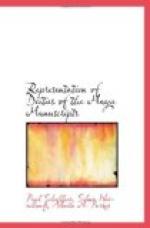The death-god is represented with extraordinary frequency in all the Maya manuscripts. Not only does the figure of the god itself occur, but his attributes are found in many places where his picture is missing. Death evidently had an important significance in the mythologic conceptions of the Mayas. It is connected with sacrifice, especially with human sacrifices performed in connection with the captive enemy. Just as we find a personification of death in the manuscripts of the Mayas, we also find it in the picture-writings of the ancient Mexicans, often surprisingly like the pictures of the Maya codices. The Aztec death-god and his myth are known through the accounts of Spanish writers; regarding the death-god of the Mayas we have less accurate information. Some mention occurs in Landa’s Relacion de las cosas de Yucatan, Sec. XXIII, but unfortunately nothing is said of the manner of representing the death-god. He seems to be related to the Aztec Mictlantecutli, of whom Sahagun, Appendix to Book III, “De los que iban al infierno y de sus obsequias,” treats as the god of the dead and of the underworld, Mictlan. When the representations of the latter, for example in the Codex Borgia, and in the Codex Vaticanus No. 3773, are compared with those of the Maya manuscripts, there can be hardly a doubt of the correspondence of the two god figures. In the Codex Borgia, p. 37, he is represented once with the same characteristic head ornament, which the death-god usually wears in the Maya manuscripts, and in the Codex Fejervary, p. 8, the death-god wears a kind of breeches on which cross-bones are depicted, exactly as in Dr. 9 (bottom).
Bishop Landa informs us that the Mayas “had great and immoderate dread of death.” This explains the frequency of the representations of the death-god, from whom, as Landa states, “all evil and especially death” emanated. Among the Aztecs we find a male and a female death-deity, Mictlantecutli and Mictlancihuatl. They were the rulers of the realm of the dead, Mictlan, which, according to the Aztec conception, lay in the north; hence the death-god was at the same time the god of the north.
It agrees with the calendric and astronomic character of the Maya deities in the manuscripts, that a number of the figures of the gods are used in connection with specified cardinal points. Since, according to the Aztec conception, the death-god was the god of the north, we might expect that in the Maya manuscripts also, the death-god would be always considered as the deity of the north. Nevertheless this happens only once, namely in the picture at the end of Codex Cort., pp. 41 and 42. Elsewhere, on the other hand, this god is connected with other cardinal points, thus Dr. 14a with the west or east (the hieroglyph is illegible, but it can be only west or east), and in Dr. 27c with the west. It is interesting to note that once, however, in a series of cardinal points, the hieroglyph of the death-god connected with the numeral 10 stands just in the place of the sign of the north; this is on Tro. 24* (bottom).




